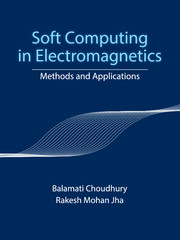Book contents
- Frontmatter
- Dedication
- Contents
- List of Figures
- List of Tables
- Preface
- Acknowledgments
- Abbreviations
- Symbols
- 1 Introduction
- 2 Soft Computing Techniques
- 3 Soft Computing in Electromagnetics: A Review
- 4 Bacterial Foraging Optimization For Metamaterial Antennas
- 5 PSO for Radar Absorbers
- 6 Characterization of Planar Transmission Lines Using ANN
- 7 Fault Detection in Antenna Arrays
- 8 Multi-Objective Particle Swarm Optimization for Active Terahertz Devices
- 9 Soft Computing based CAD Packages for EM Applications
- Author Index
- Subject Index
- References
6 - Characterization of Planar Transmission Lines Using ANN
Published online by Cambridge University Press: 05 July 2016
- Frontmatter
- Dedication
- Contents
- List of Figures
- List of Tables
- Preface
- Acknowledgments
- Abbreviations
- Symbols
- 1 Introduction
- 2 Soft Computing Techniques
- 3 Soft Computing in Electromagnetics: A Review
- 4 Bacterial Foraging Optimization For Metamaterial Antennas
- 5 PSO for Radar Absorbers
- 6 Characterization of Planar Transmission Lines Using ANN
- 7 Fault Detection in Antenna Arrays
- 8 Multi-Objective Particle Swarm Optimization for Active Terahertz Devices
- 9 Soft Computing based CAD Packages for EM Applications
- Author Index
- Subject Index
- References
Summary
Advancements in microwave integrated circuits (MIC) are occurring at a rapid pace. Features of MIC such as small size and the possibility of realization of entire systems on a single chip have led to the increase in the usage of these devices in communication systems. One of the integral elements of these MICs is transmission lines. Transmission lines are not just used to connect individual modules inside the MIC but they are also essential in the realization of components like filters, mixers, couplers, and power dividers. Popular types of transmission lines used include microstrip lines, strip lines, grounded waveguides, slotlines, etc. As a result, these transmission lines must be designed carefully and analyzed; deviations in the design will lead to errors in the operation of the MIC. Traditional methods of analysis of transmission lines include conformal transformation, variational method, spectral domain method, and numerical methods like finite element method (FEM), finite difference method, and finite difference time domain method. These methods are extremely accurate and have been documented to produce results that concur with experimental observations. However, complex mathematical formulation and iterative nature imply high computational time requirement [Bhatt and Koul, 1990; Schellenberg, 1995]. This quality limits the application of these techniques in situations where quick solutions are required such as CAD packages for transmission line design. The algorithms based on artificial intelligence could be used in order to create such CAD packages. Yildiz et al. [Yildiz et al., 2004] used neural network for analysis of co-planar waveguide. The same algorithm was further used for the analysis of inverted microstrip lines [Yildiz and Saracogulu, 2003]. Although the analysis of planar transmission lines using neural network has been explored, the design of various configurations of transmission lines using NN is yet to be done.
In this chapter, the analysis and the design of various configurations of transmission lines, namely the microstrip line and the slotline, are conducted using artificial neural networks. The corresponding formulation and ANN implementation are discussed in detail.
Planar Transmission Lines
As mentioned earlier, different types of transmission lines are used in the fabrication of MIC depending upon the requirement. In this chapter, the focus is limited to two types of planar transmission lines viz. microstrip transmission lines and slotline transmission line.
- Type
- Chapter
- Information
- Soft Computing in ElectromagneticsMethods and Applications, pp. 111 - 123Publisher: Cambridge University PressPrint publication year: 2016



